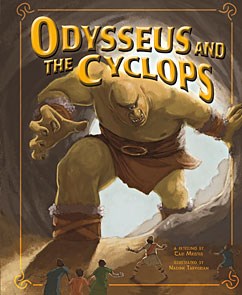Title of the work
Country of the First Edition
Country/countries of popularity
Original Language
First Edition Date
First Edition Details
Cari Meister, Odysseus and the Cyclops, Greek Myths. London: Raintree: an imprint of Capstone Global Library Limited, 2012, 32 pp.
ISBN
Genre
Adaptations
Illustrated works
Myths
Target Audience
Children (8–10 ages)
Cover

Cover photo courtesy of Capstone (accessed: September 10, 2019).
Author of the Entry:
Ayelet Peer, Bar-Ilan University, ayelet.peer@biu.ac.il
Peer-reviewer of the Entry:
Lisa Maurice, Bar-Ilan University, lisa.maurice@biu.ac.il
Susan Deacy, University of Roehampton, s.deacy@roehampton.ac.uk

Photo courtesy of Cari Meister and Steve Henke from her official website (accessed: June 26, 2018).
Cari Meister (Author)
Cari Meister studied at Clark University and currently lives in Minnetrista, Minnesota. Her book Airplane Adventure was named “Parents” magazine Best Book of 2010.
Sources:
Official website (accessed: June 26, 2018).
Profile on Caprstone's website (accessed: June 26, 2018).
Profile on amazon.com (accessed: 08.08.2022).
Bio prepared by Allison Rosenblum, Bar-Ilan University, allie.rose89@gmail.com

Photo courtesy of the Illustrator.
Nadine Takvorian (Illustrator)
Nadine Takvorian is an American artist from Berkeley, California, USA. She works both as an illustrator and as an author. She produces the illustrations for children's books and graphic novels. She lives in Berkeley, California with her family.
She is the recipient of several awards, including being the Runner up for the SCBWI Martha Weston Grant, 2016 and receiving the Special Jury Award for Animation – South by Southwest Film Festival (SXSW). Her Clients have included Learning A-Z, Capstone Press, Scholastic and others.
Source:
Official website (accessed: October 15, 2018)
Bio prepared by Tikva Schein, Bar-Ilan University, tikva.blaukopf@gmail.com
Summary
This book illustrates the encounter between Odysseus and his crew and the Cyclops Polyphemus. The book briefly introduces Odysseus and his return from Troy, prior to his meeting with the Cyclops. In the end, due to Odysseus’ ingenuity, the Greeks manage to escape the cave and the Cyclops is shunned by his peers.
Analysis
As noted, the book centers on Odysseus’ meeting with the Cyclops. Therefore the introduction to the character of Odysseus is short. It is noted that the gods were angry with Odysseus and his men for sacking a temple. This explanation is a diversion from the myth yet it portrays Odysseus as an impious man. However, besides being forced to roam the seas for ten years, there are no more repercussions set down by the gods (mentioned in this introduction) and the meeting with the Cyclops is therefore not preordained by the gods but an unfortunate incident.
However, while Odysseus is portrayed in this story as wise, his less favorable qualities are emphasized. For example, while his men are anxious to leave the island, his curiosity leads him to explore the Cyclops’ cave. Furthermore, he is the one who insists on meeting the mysterious successful shepherd from the cave. It is hard to decide whether Odysseus was blinded by greed at the sight of the cave’s rich produce or by his curiosity, yet his decision led to the catastrophe that befell his men. The mention of Odysseus’ curiosity is interesting, for it portrays him in a manner resembling Pandora, whose story has also been retold by this book’s author. It appears that Odysseus deliberately led his men to danger, especially since it is stated that they had already eaten their fill on the shore, and thus it was not hunger which led them to the cave, but purely Odysseus’ will.
The Cyclops is depicted as a fearsome and evil brute, who relishes in eating Odysseus’ crew. This is well emphasized in the page-long illustration, of this huge, drooling, man-beast. In the final scene, the Greeks are shown releasing themselves from the sheep, and Odysseus is nervously gazing forward, although whether at the reader or at the cave is uncertain. Yet he appears more distraught than in the beginning, where he looked more confident and resolute, and it may be that he does realize the full impact of his actions.


